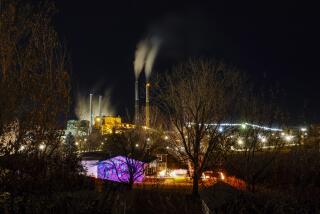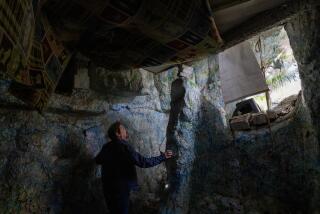Wildcatters Hope to Drill Again : Oil: Is there an untapped pocket in Towsley Canyon? Partners in a consortium now lack the money to find out.
The giant oil rig is gone from Towsley Canyon, less than a year after Canadian wildcatters dragged it there with dreams of coaxing black gold from an old, unused oil field owned by Chevron Corp.
They found oil in the Santa Clarita woodlands, all right, but itâs mixed with so much water that itâs not worth retrieving. And the oilmen, a consortium of Canadian geologists and investors, plus the Samedan Oil Corp., based in Ardmore, Okla., have run through nearly $7 million--almost all of their capital.
So for now, at least, operations have been shut down.
Still, Robert Grey, a 64-year-old wildcatter who is president of the company with the largest stake in the enterprise, says heâs not giving up.
âWeâre in this for the big one,â said Grey, who is president of Riva Petroleum, a Canadian company listed on the Vancouver stock exchange that owns 45% of the project. âAnd the only way to get to the big one is to drill another hole.â
Grey is convening a meeting of the consortium participants--Loumic Resources, Tusk Resources, Samedan, a division of Noble Affiliates, and Riva--on Jan. 28 to try to persuade them to drill again, an endeavor that will cost another $4.3 million, Grey said. One earlier participant dropped out altogether, and another, Layfield Resources, is no longer an active partner, although it will receive 1.5% of the proceeds if the well produces oil or gas.
Oklahoma-based Samedan, which has been running operations for the Canadian project and holds an 8% stake, has not decided whether it will stay on, said production superintendent Gary Brune.
Grey said that geological tests conducted since the project began last year indicate that there is an oil deposit on the land, but it canât be reached by the existing well.
âItâs not as speculative as it was when we first went in, because weâve got the geology pretty well figured out now,â Grey said. âThere is definitely something down there.â
If Grey persuades the partners to stay on, and they raise the additional money, the group will face two choices: make the existing well give up more oil, or drill another well.
The partners are working on land leased from Chevron on one of the oldest oil fields in California. The oil deposits there, part of a geologic formation called the Pico Anticline, have been known for more than 1,000 years, ever since local Indians used the tar that bubbled up from the ground to seal their baskets.
The existing well--which is actually an old well that the partners extended by about 5,000 feet to 15,800 feet--can be made more productive, said Norman Holton, a geologist who is a director of Riva and president of Tusk, which has a 17% stake in the project.
Through chemical treatments or by physically altering the rock, the oil reservoir in the rock can be made more permeable, Holton said. That means fluid would flow more quickly, and the wildcatters would get more oil.
The process would cost about $200,000, according to Grey, but would not result in the billions of dollars worth of oil the investors say they are looking for.
âWe have a low grade commercial oil well with possibilities to enhance the economic viability,â Holton said. But that well, he said, will never be a giant.
Grey said he is committed to the idea of drilling a new well, and hopes to begin working on it in July or August. It would be near the old one, but dug from a location and angle that would allow the wildcatters to reach what they believe is a more oil-rich part of the reservoir.
In order to do that, however, the partners will have to kick in enough money to cover the cost. And according to Holton, most of the money raised thus far for the venture has been spent, and the partners have little in the bank.
According to financial documents filed by the companies, Riva had just $1.2 million in U.S. dollars in cash and bank accounts as of Sept. 30. Tusk, with a 17% stake in the project, had only $114,071.
In order to continue, the partners--all public companies--must either sell additional stock to finance the venture, or bring in new partners with deep pockets.
âItâs been disappointing in one sense,â Holton said. âBut based on my experience in the oil industry, itâs very unusual to nail the bullâs-eye with the very first well on a major project like this.â
But Chevron has capped the 88 wells it once ran on the 2,400-acre oil field it owns in the woodlands, saying that the field was low-producing and slow by todayâs standards.
And although the oil company stands to win a 30% stake in the project if the Canadians strike oil, Chevron declined to invest in it, or participate in any way.
âWe wish them well, but our geologists and geophysicists had a different opinion than theirs,â said company spokesman G. Michael Marcy. âOur experts didnât feel there were the reserves there that would make it worthwhile for Chevron to invest its money.â


